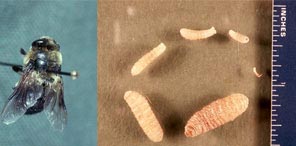Diseases and Parasites of Maryland Deer
Main_Content
Nasal Bots |
|
Fly larvae of the genus Cephenemyia live in the nasal passages and retropharyngeal pouches of deer. The adult fly
lays an egg packet on the deer’s skin around the nose or mouth. The deer
licks the egg packet and the larvae are released into the deer’s mouth. The
larvae grow within the deer’s nasal passages. Mature larvae drop on the
ground to pupate in the soil. Hunters find these larvae (nasal bots)
when dressing and butchering deer. Nasal bots are not harmful to the deer and
do not make the meat unsuitable for consumption. |
|

Photograph of fly next to egg packets
|

Bots in deer nasal cavities
|
Acknowledgements:
Photographs are used with the permission of the Southeastern
Cooperative Wildlife Disease Study located at the University of Georgia,
College of Veterinary Medicine.
For more information about white-tailed deer parasites and diseases, visit the Southeastern Cooperative Wildlife Disease Study Web site.
The publication “Field Manual of Wildlife Diseases in the Southeastern
United States” (third edition) by William R. Davidson and Victor F.
Nettles explains and describes in detail parasites and diseases of
southeastern birds and mammals. It is available for purchase through
the website listed above.
Maryland Department of Natural Resources
Wildlife and Heritage Service
Tawes State Office Building, E-1
Annapolis MD 21401
410-260-8540
Toll-free in Maryland: 1-877-620-8DNR, Ext. 8540
E-Mail: [email protected]